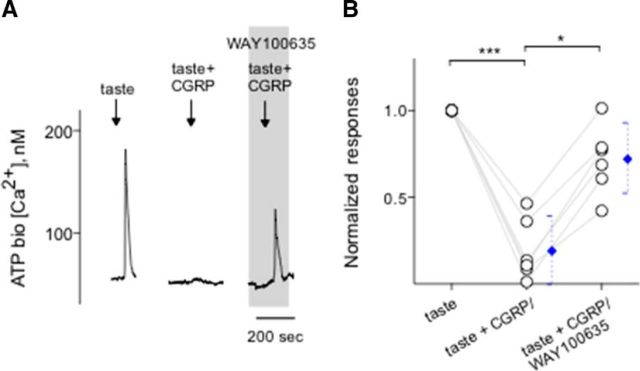Figure 7.
CGRP inhibits ATP secretion from taste buds. CHO/ATPP2X2/P2X3 cells (hereafter called ATP biosensors) were used to monitor taste-evoked ATP secretion from isolated taste buds. The extracellular 5-HT inhibits Receptor (Type II) cells (Huang et al., 2009). Whole taste buds were isolated from mouse vallate papillae to retain cell-to-cell communication between Receptor (Type II) and Presynaptic (Type III) cells. A, Traces represent robust responses from the biosensor positioned against an isolated taste bud when the taste bud was stimulated by a sweet-bitter taste mix (↓, taste; 1 mm sucralose, 0.1 mm SC45647, 10 μm cyclohexamide, 1 mm denatonium), indicating ATP secretion from the taste bud. Taste-evoked ATP secretion was inhibited by 0.1 μm CGRP (↓, taste + CGRP). Adding WAY100635 (0.01 μm), a 5-HT1A receptor blocker, to the bath (present throughout the shaded area) rescued CGRP-inhibited ATP secretion, suggesting that CGRP plays as an inhibitory transmitter via the serotonergic signaling in taste buds. B, Summary of CGRP-inhibited taste-evoked ATP secretion before and during the presence of WAY100635. Points indicate normalized peak biosensor responses. Blue symbols represent mean ± 95% CI. *p < 0.05, ***p < 0.001 (paired Student's t test). N = 6.

